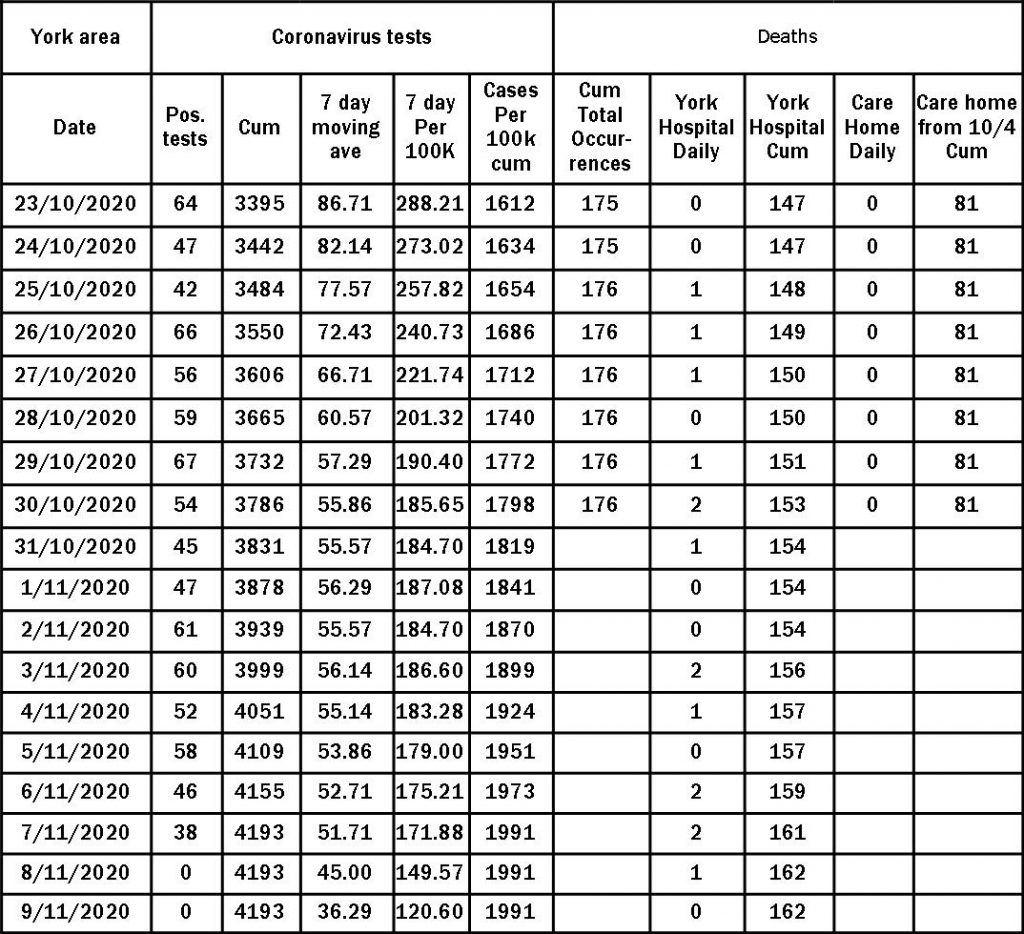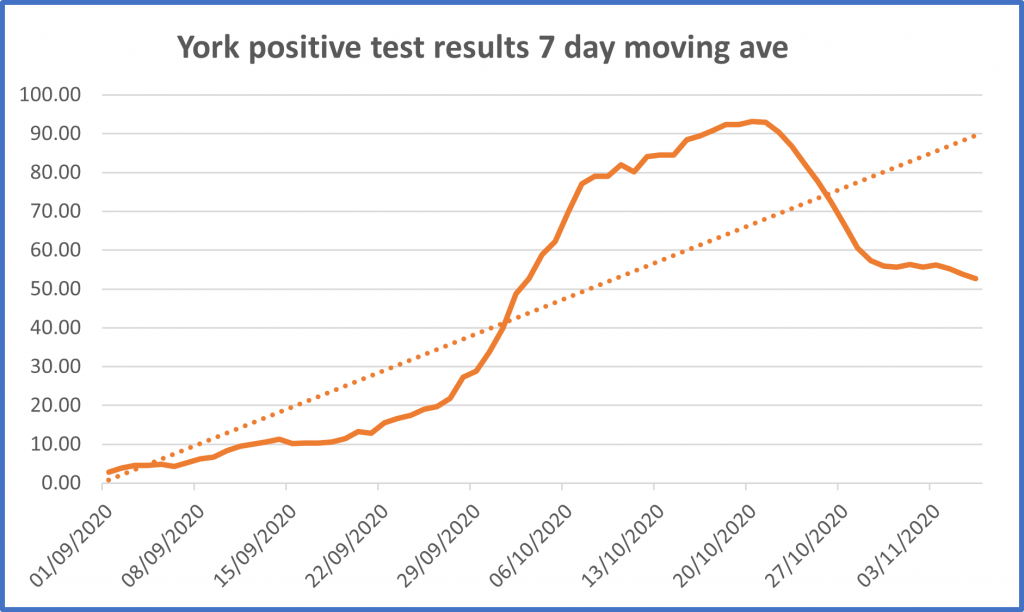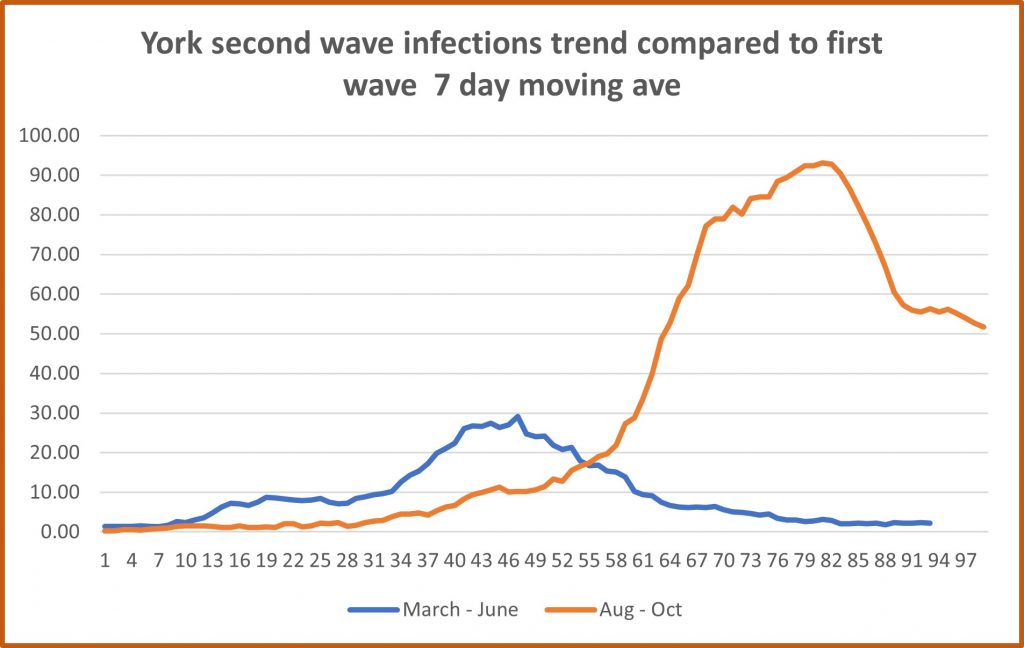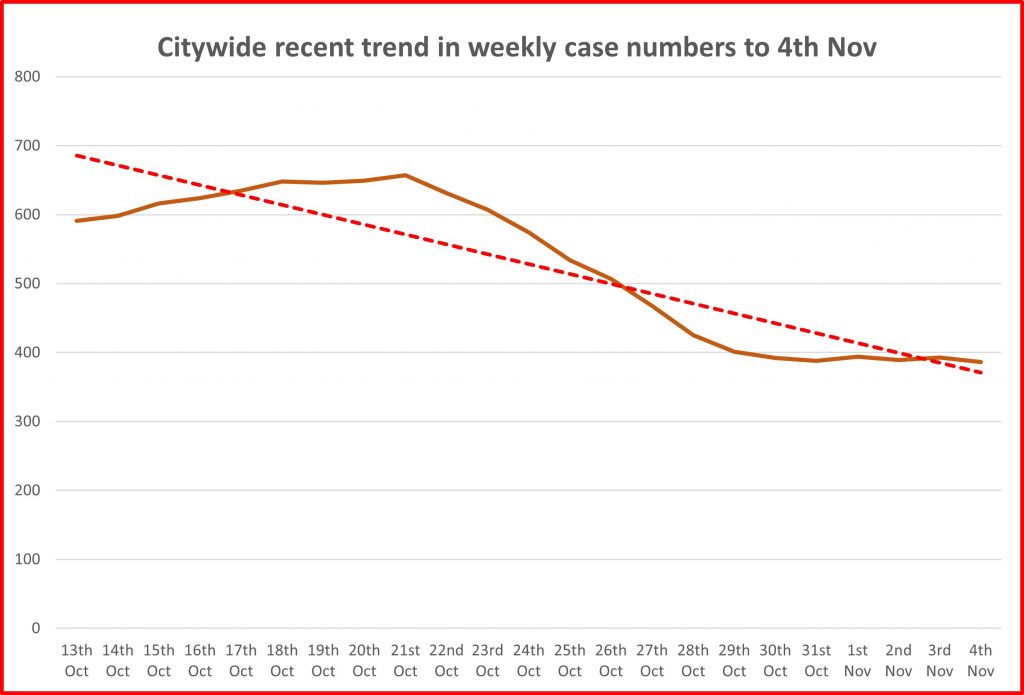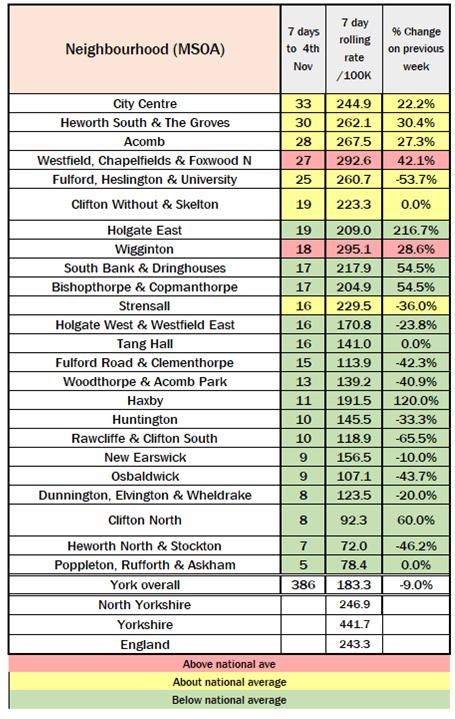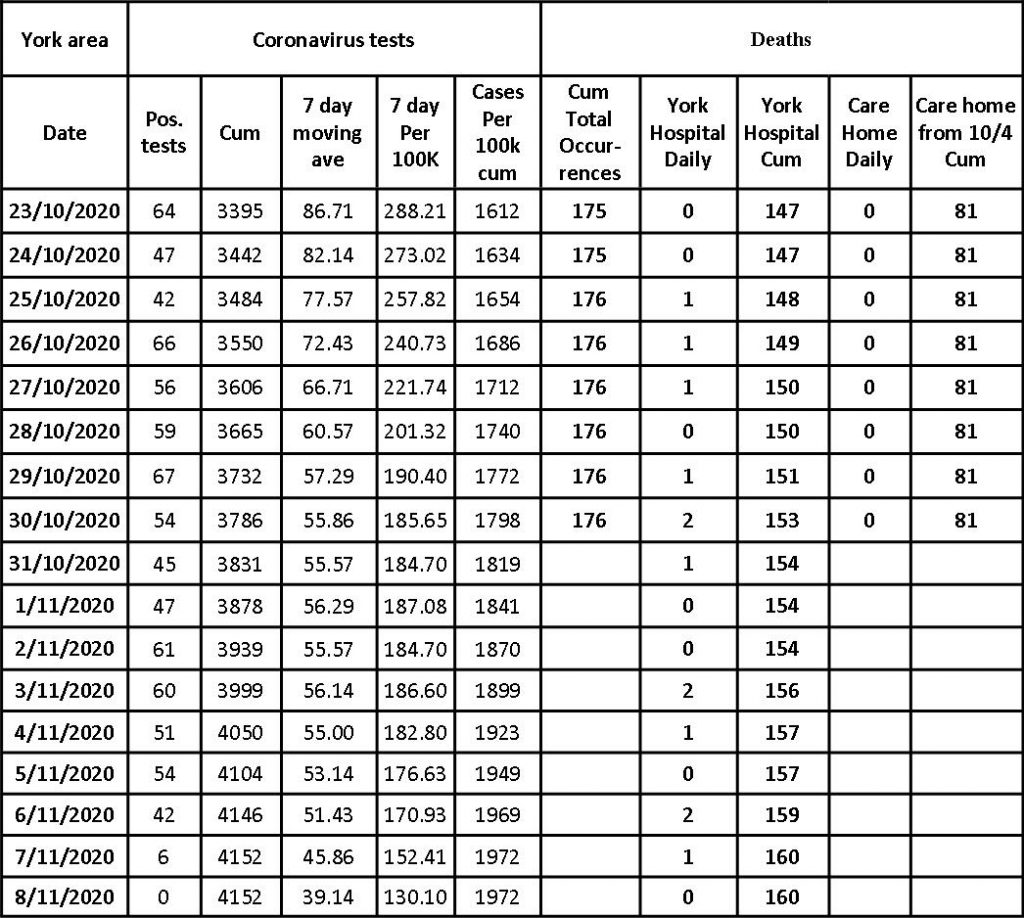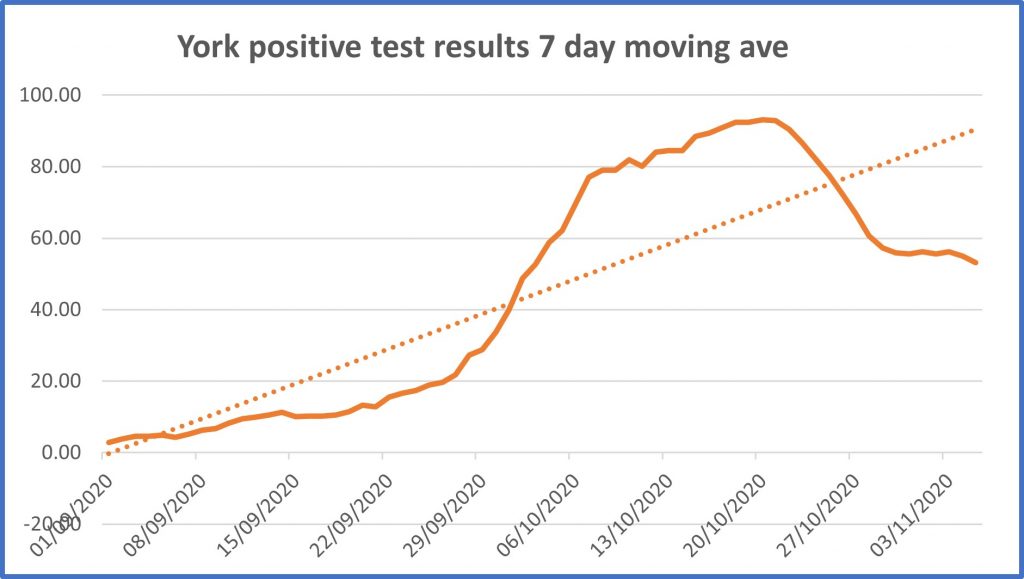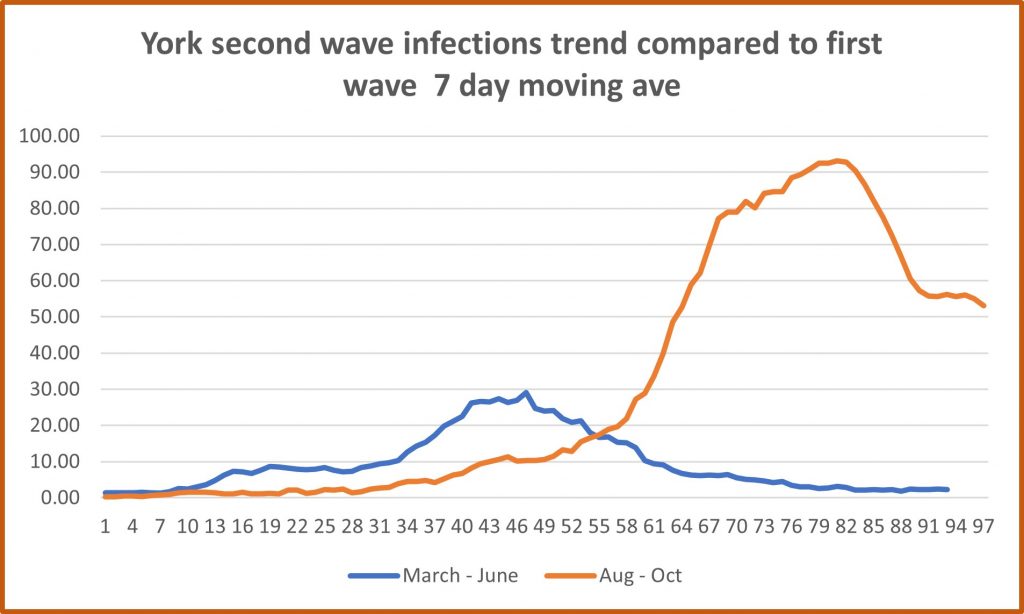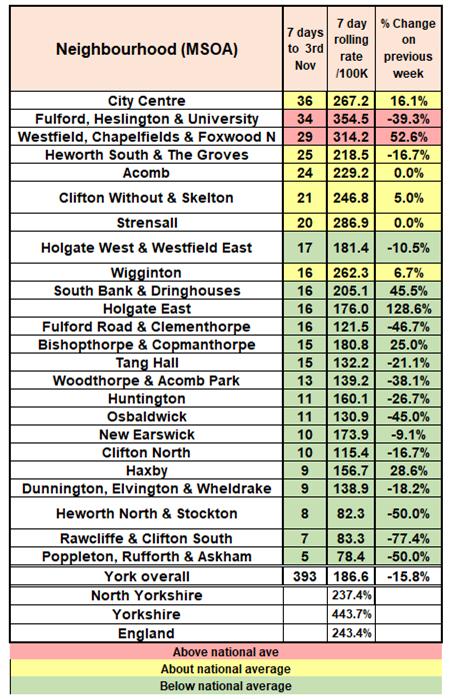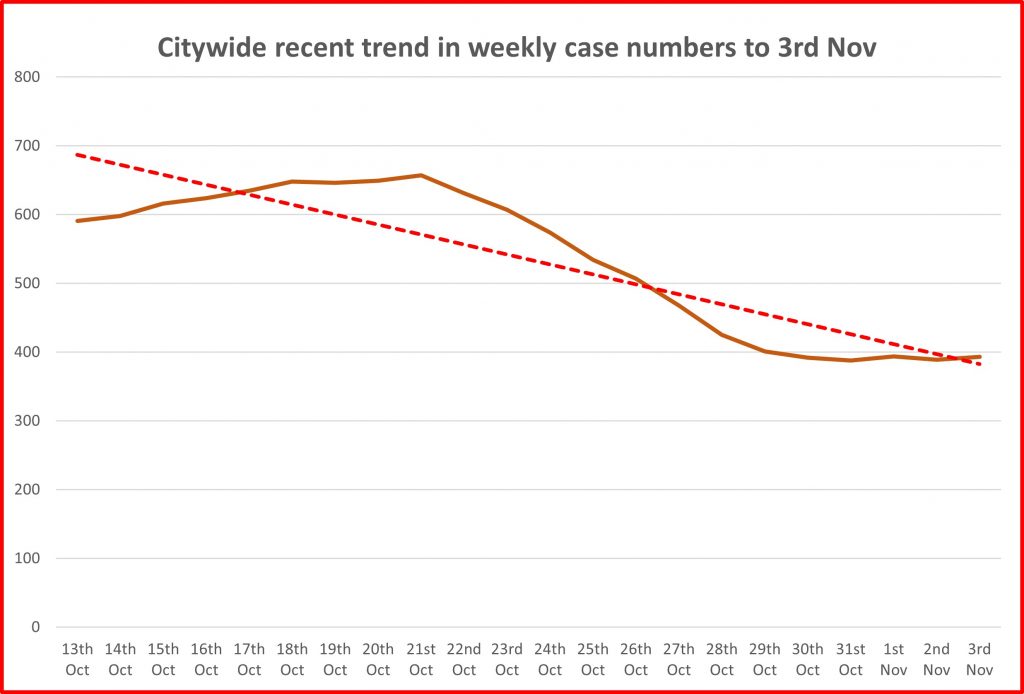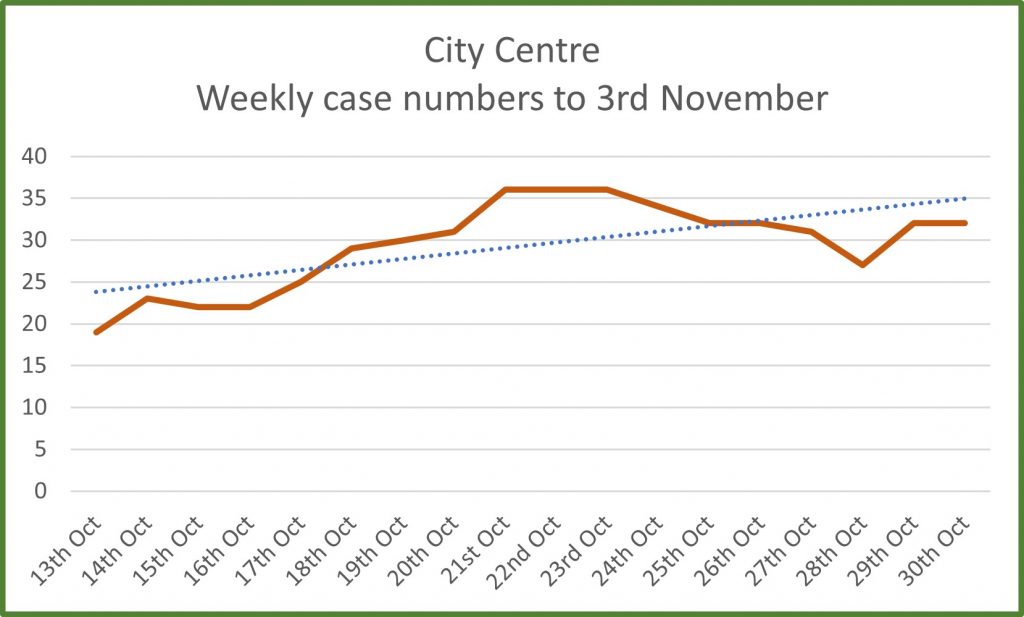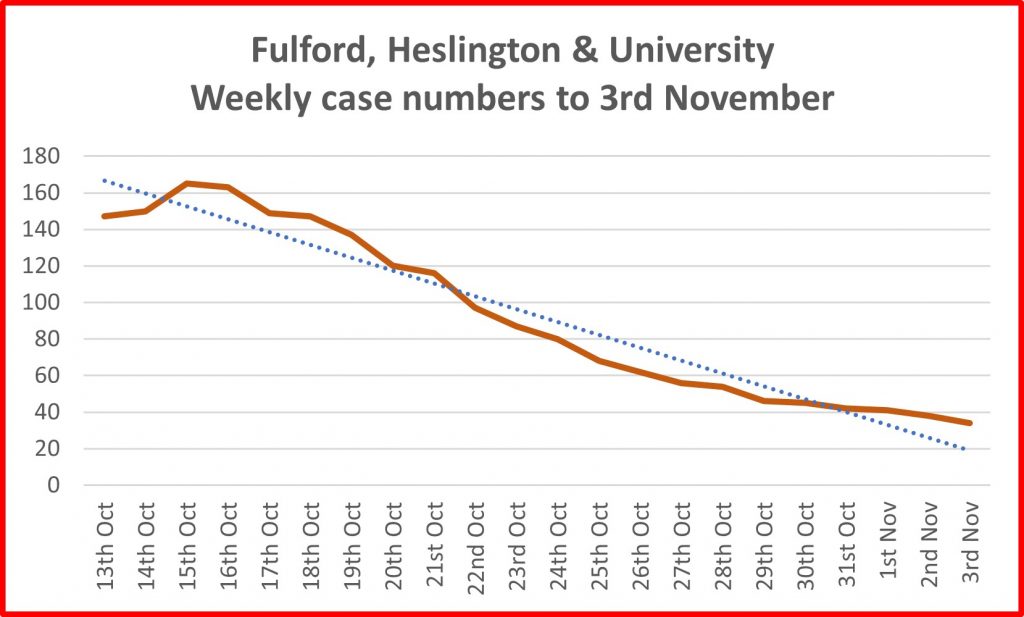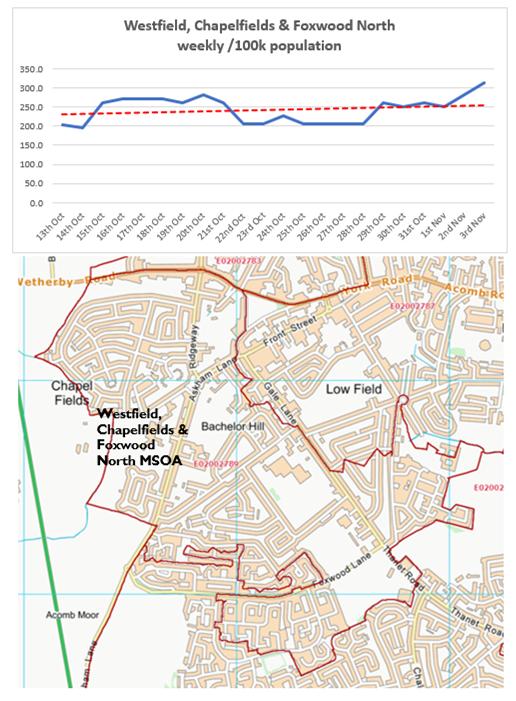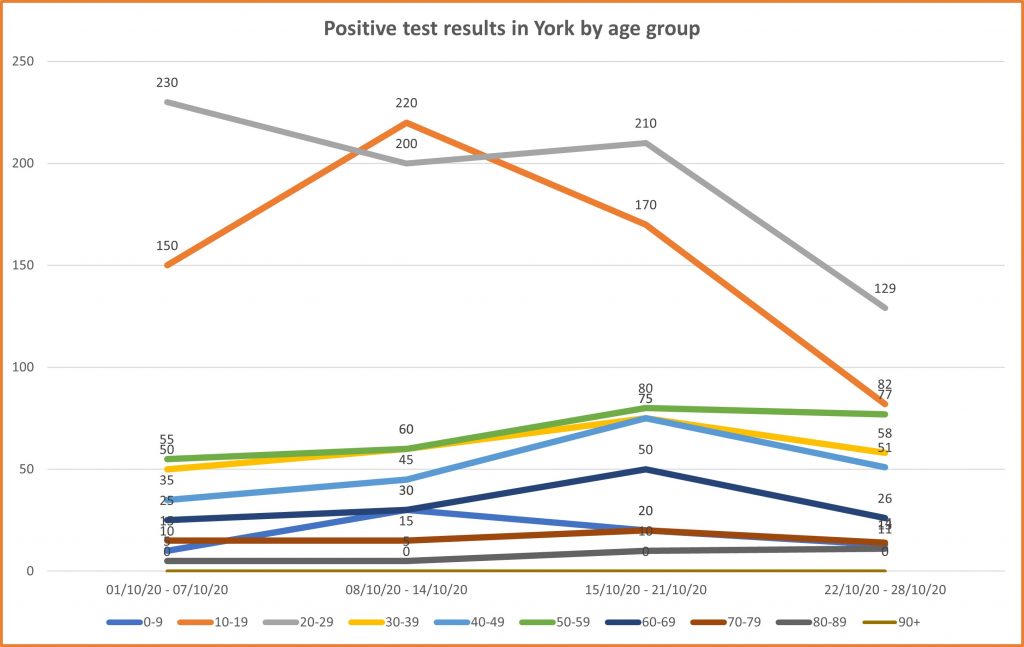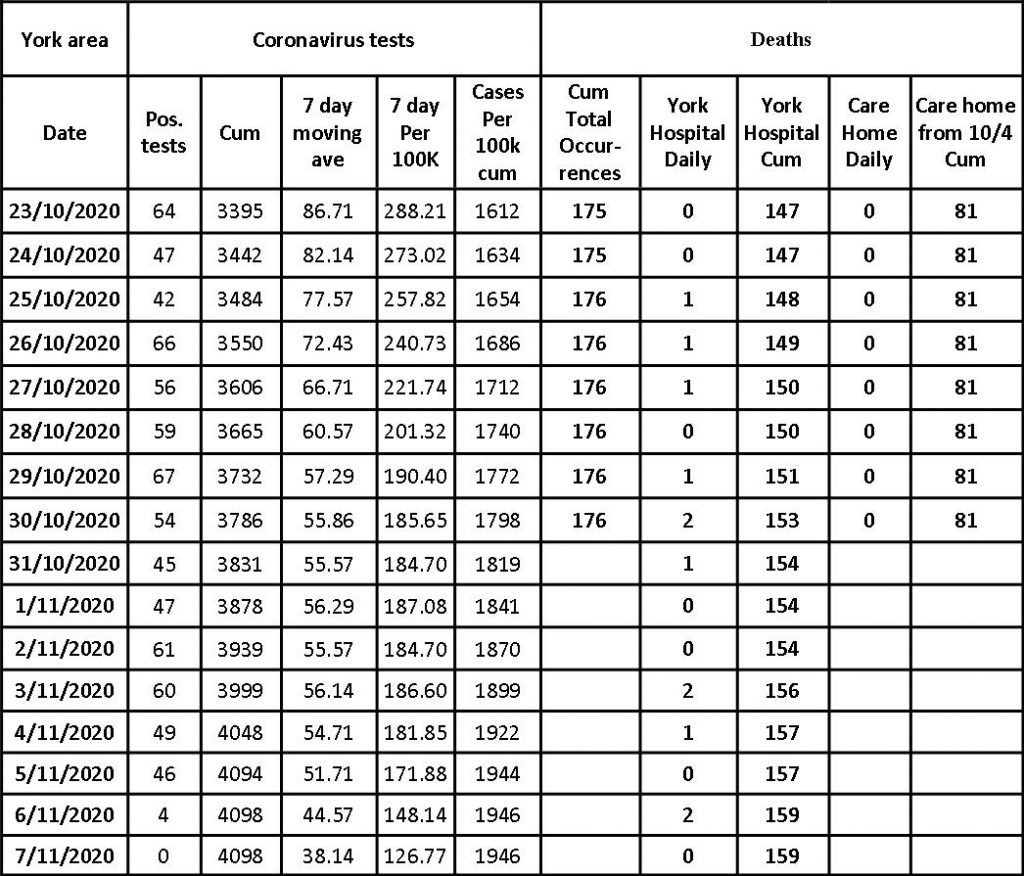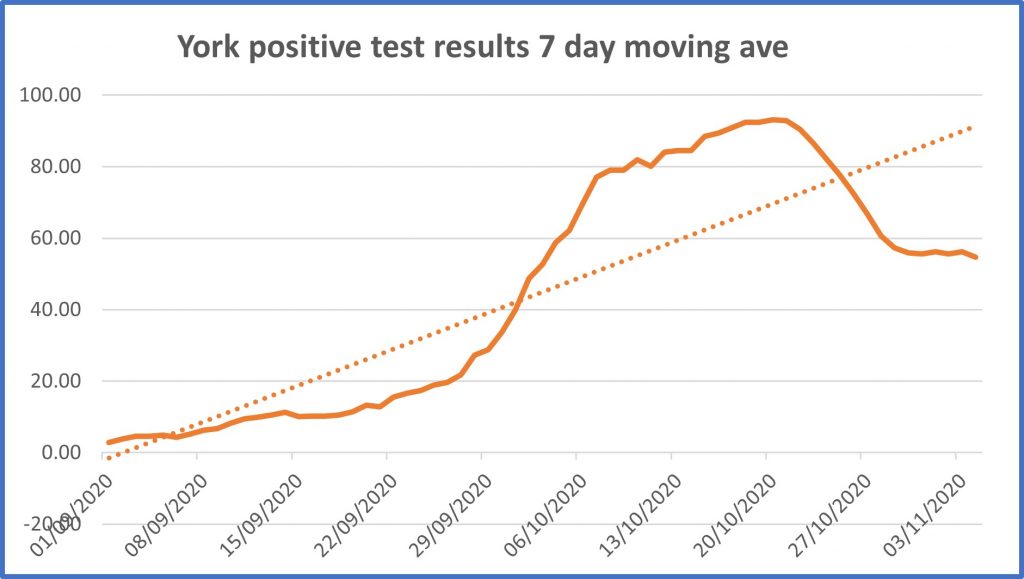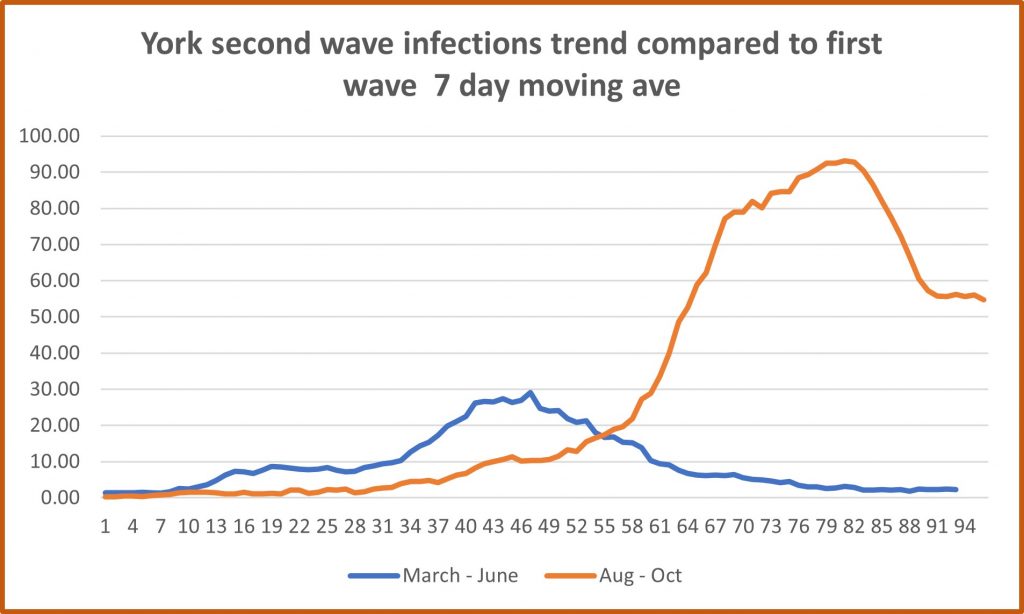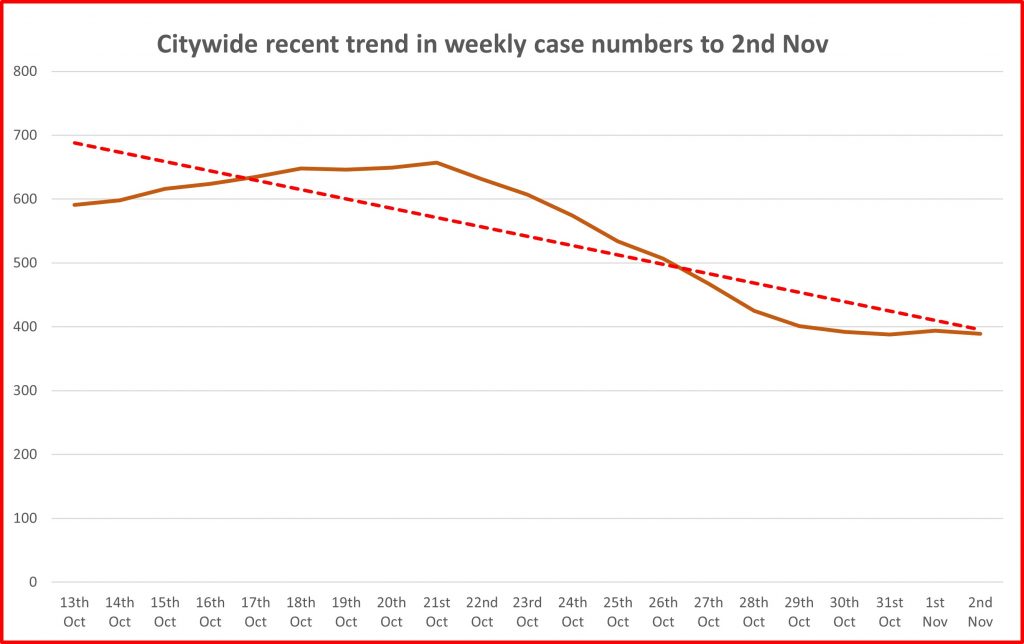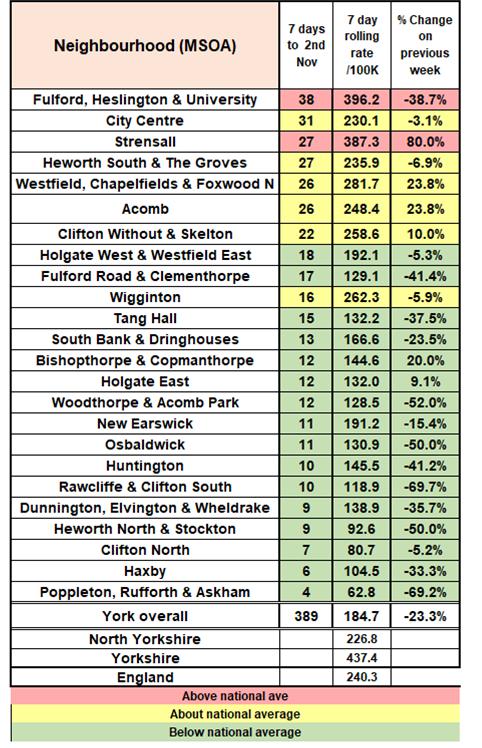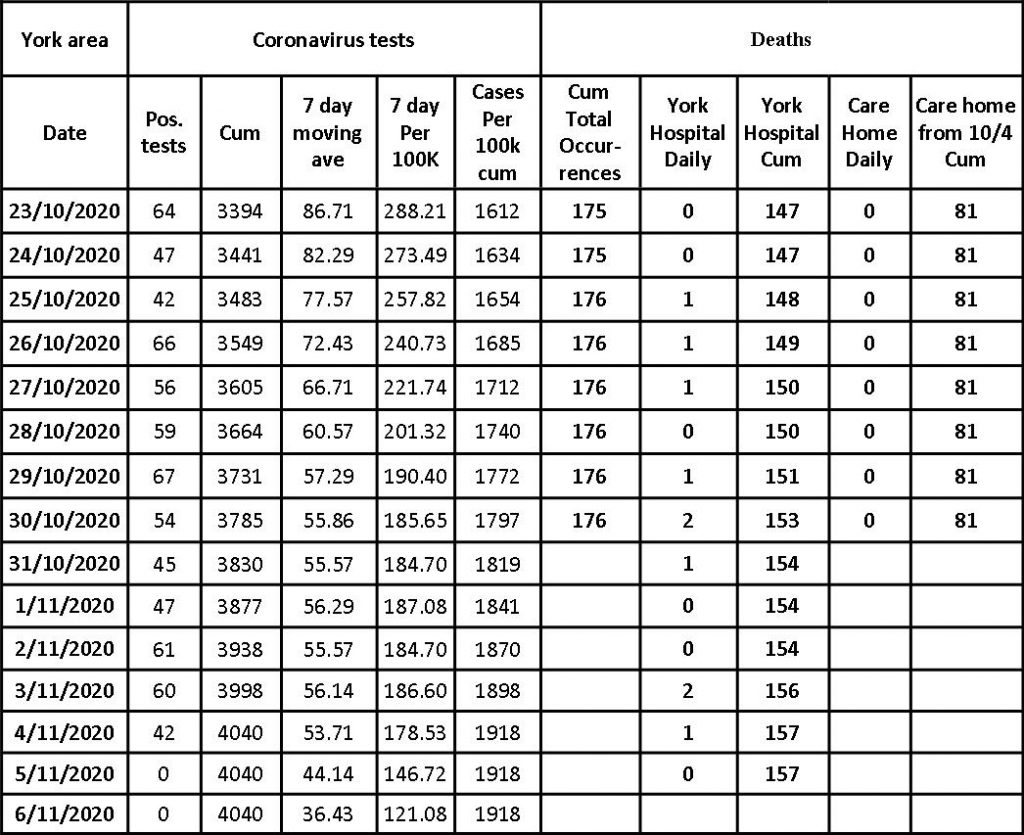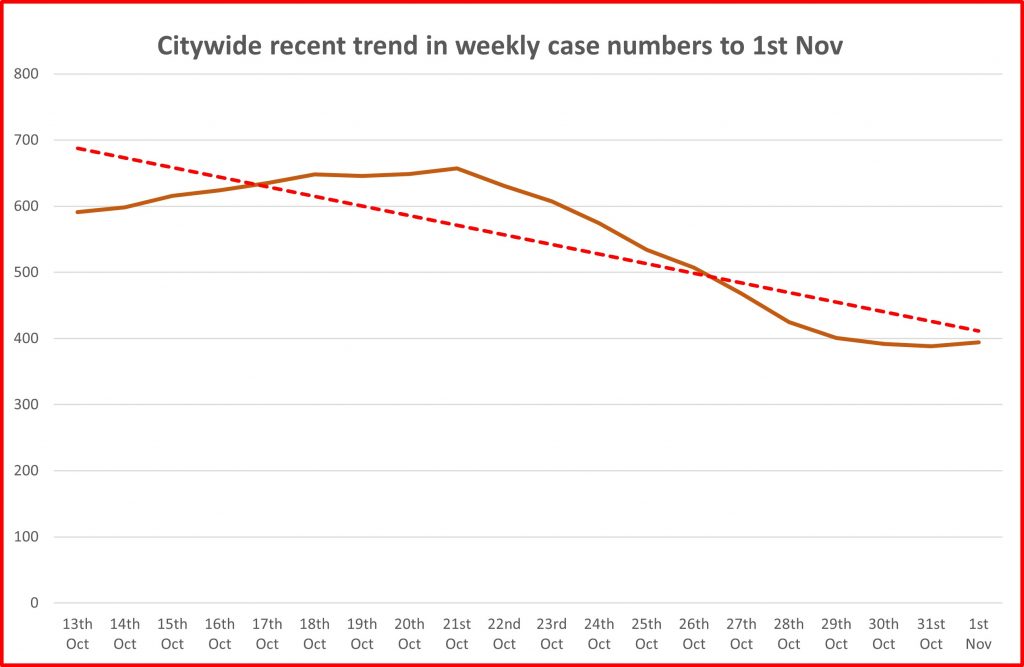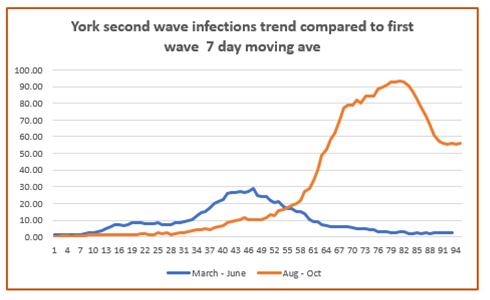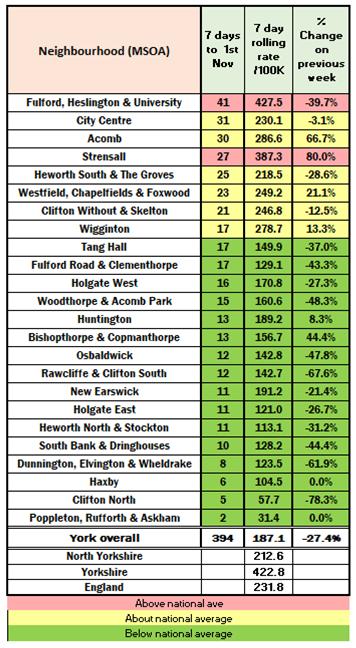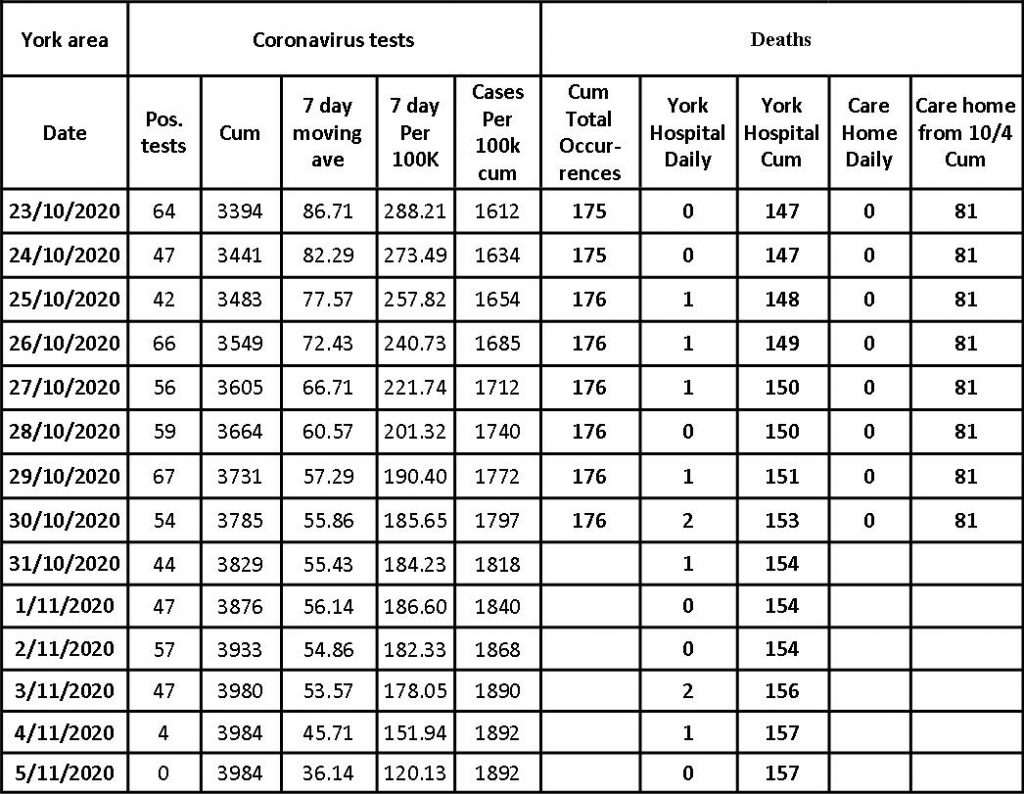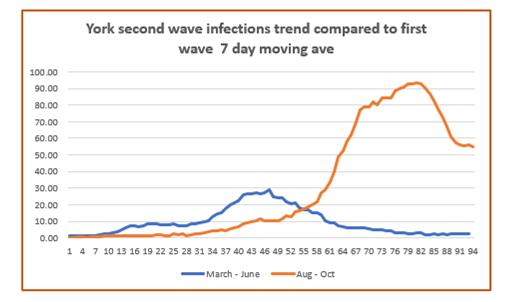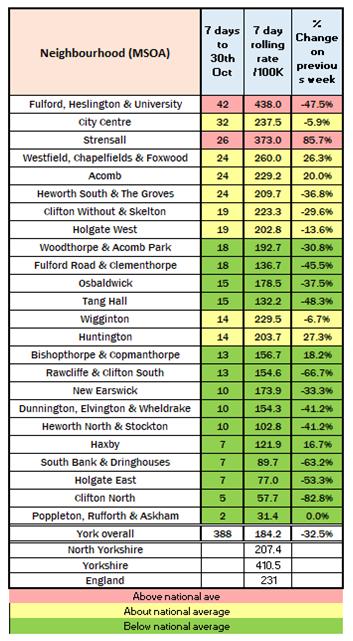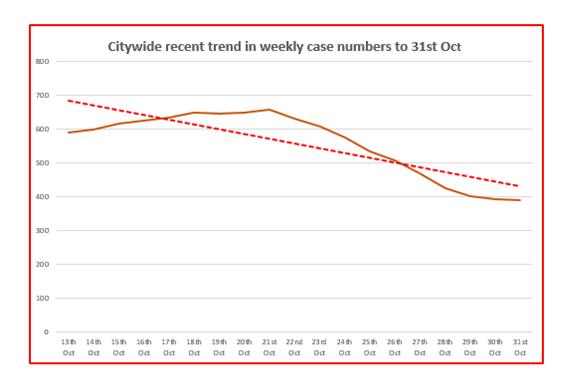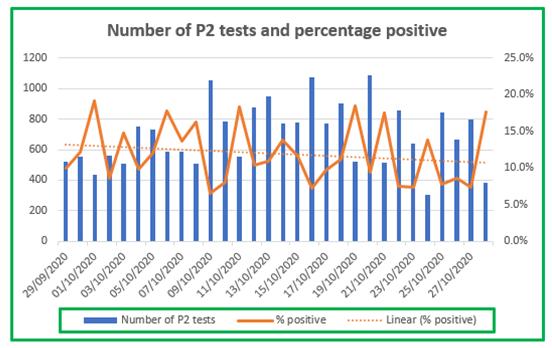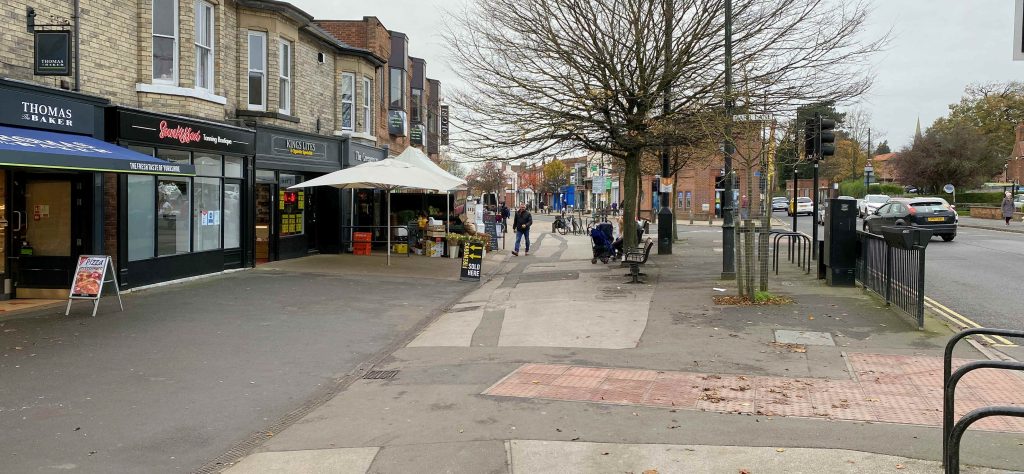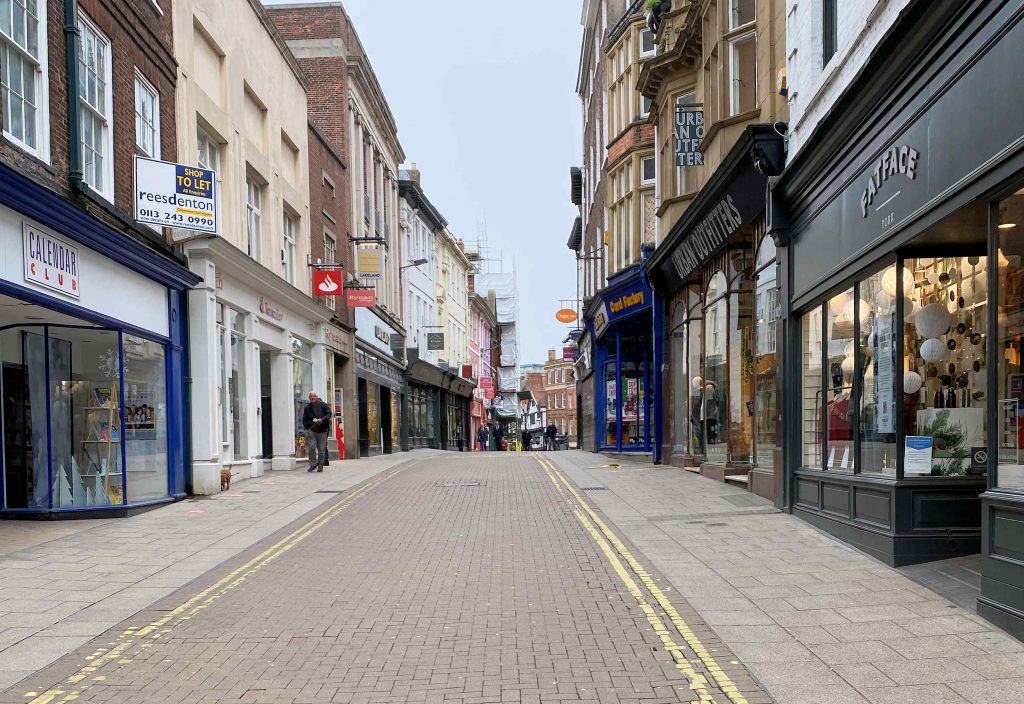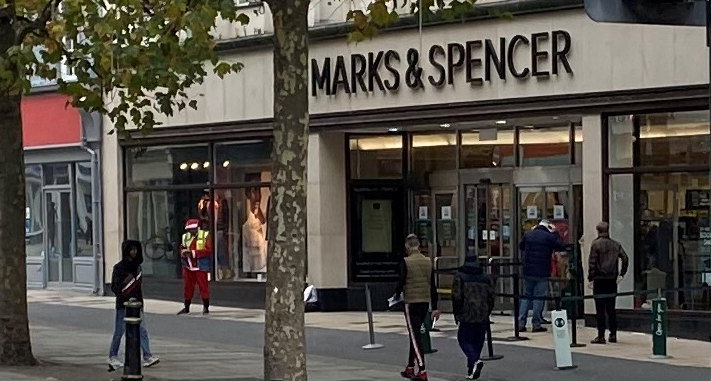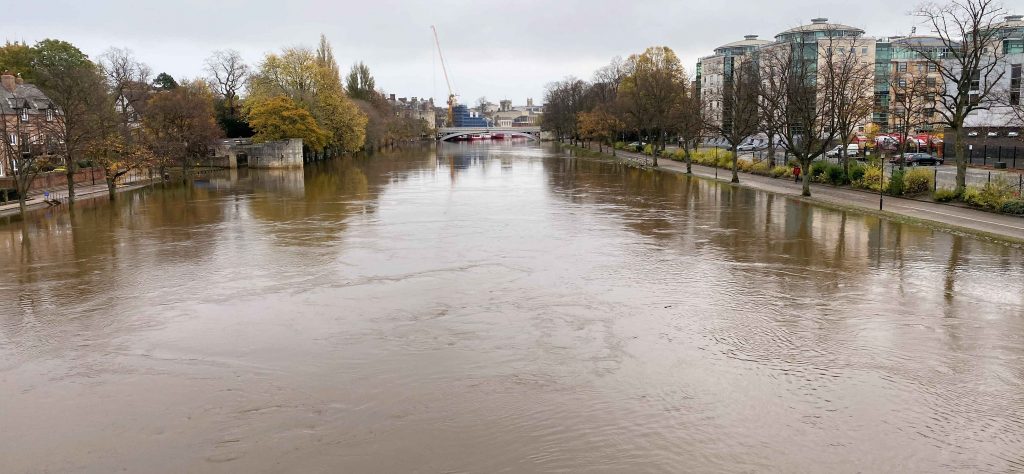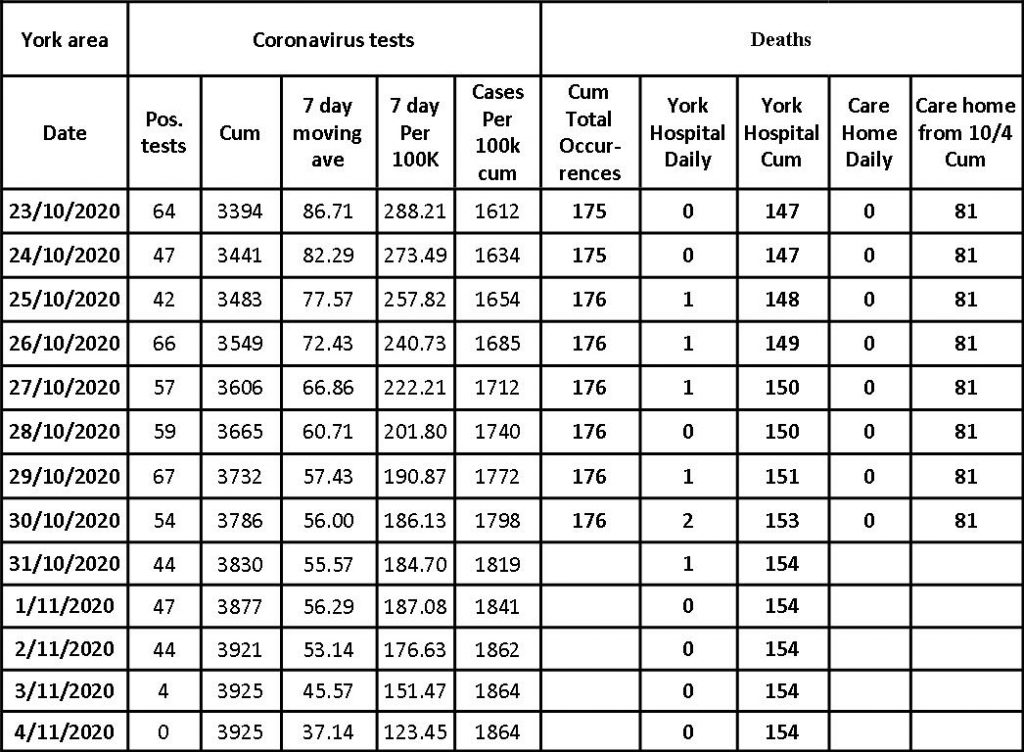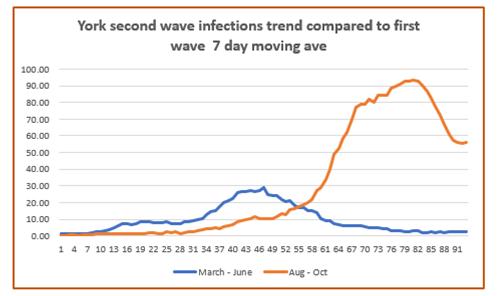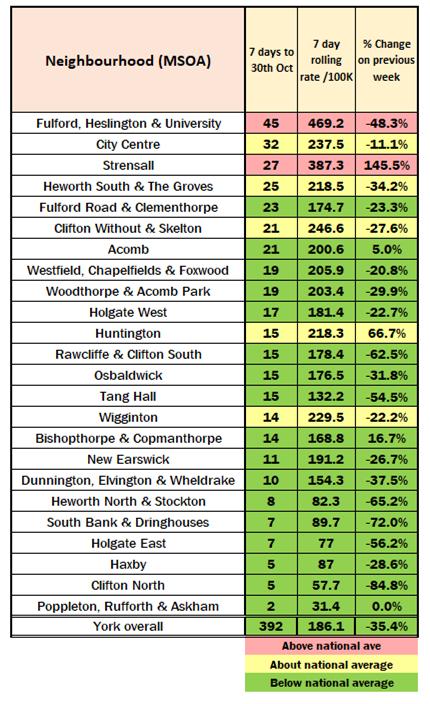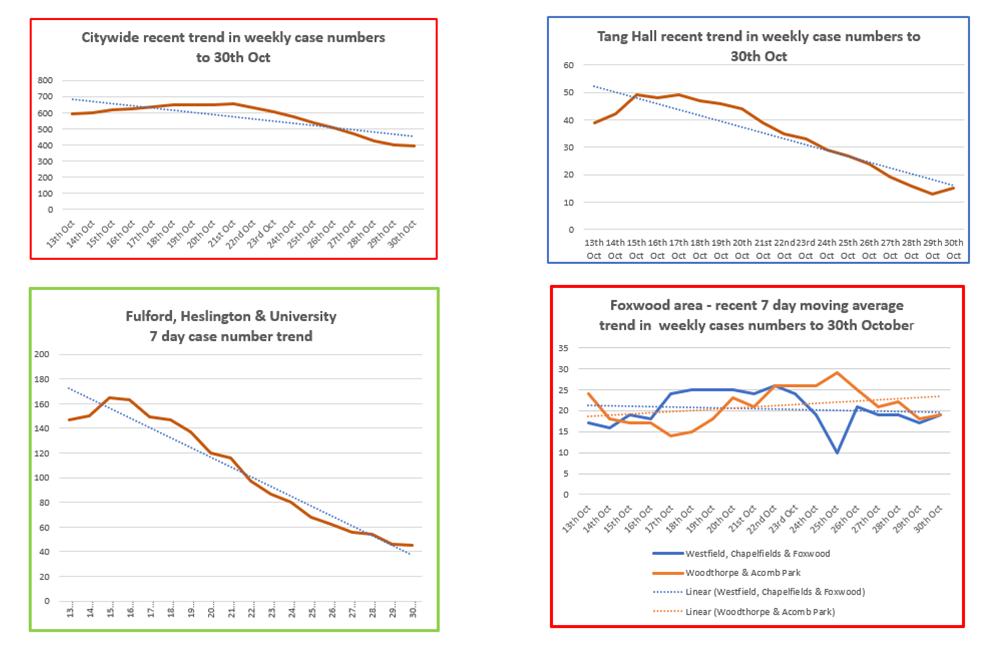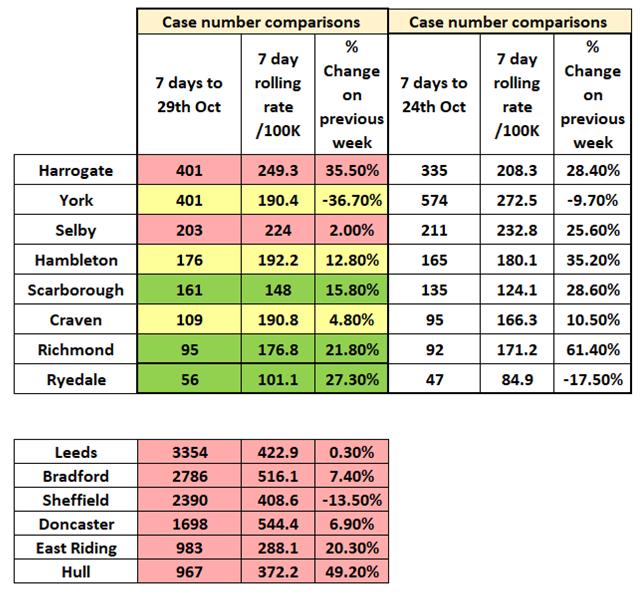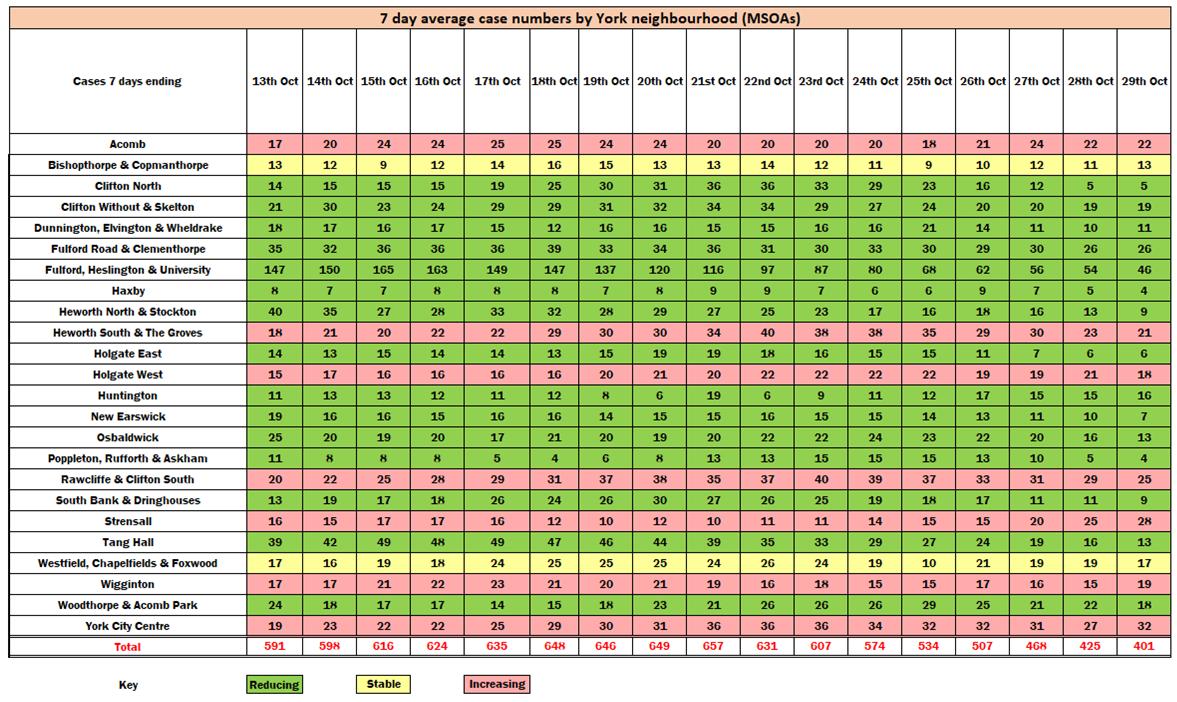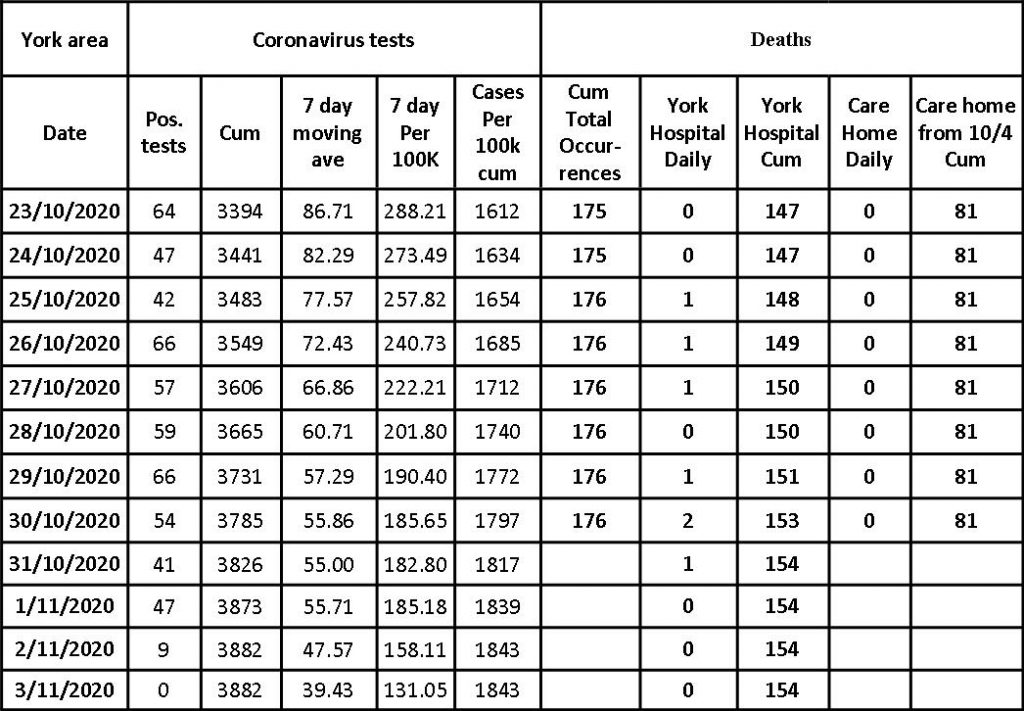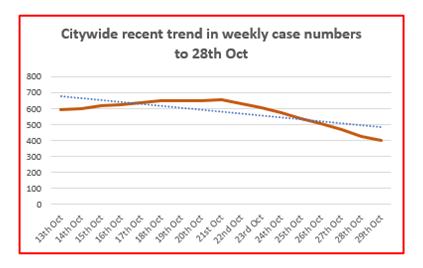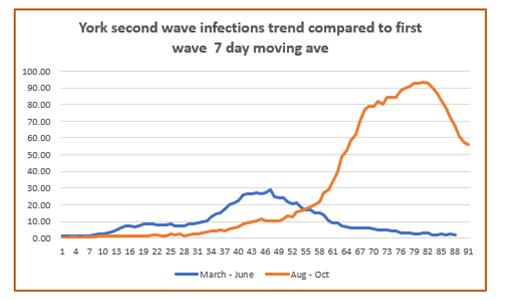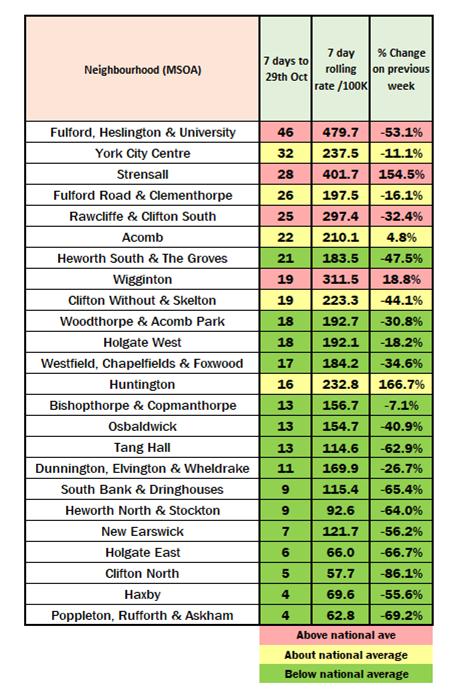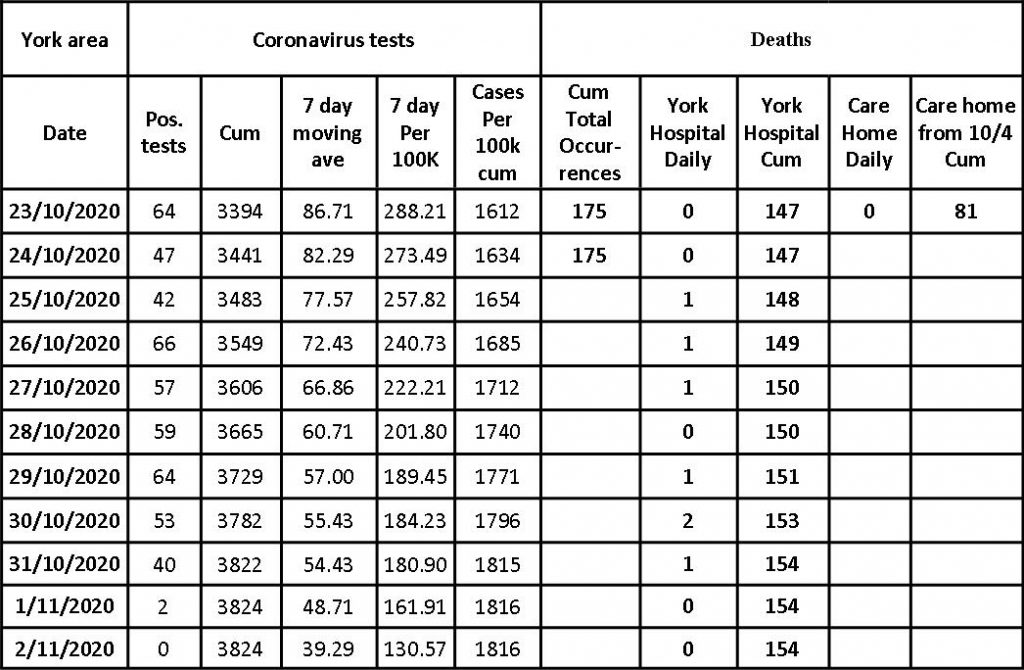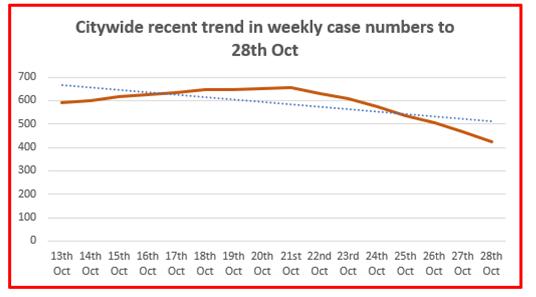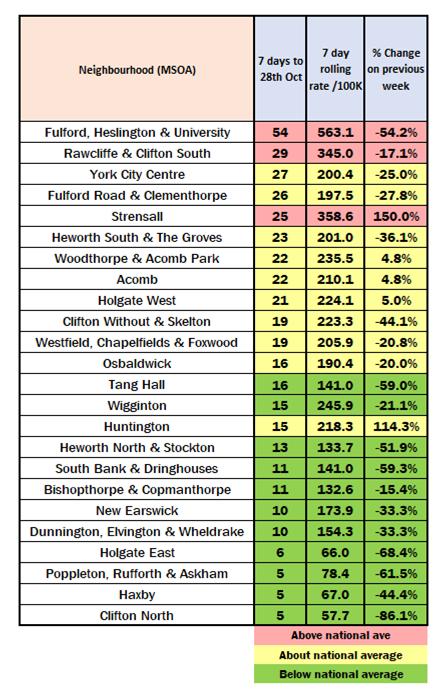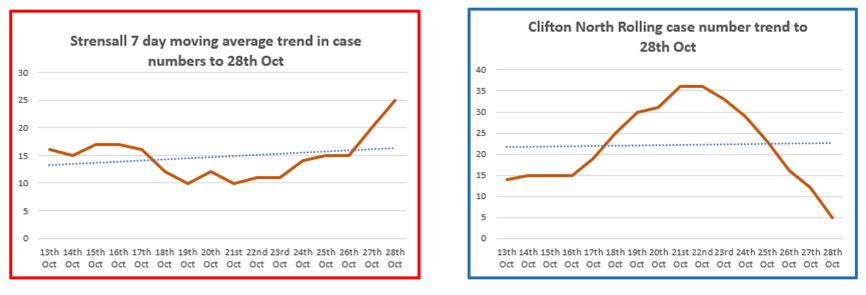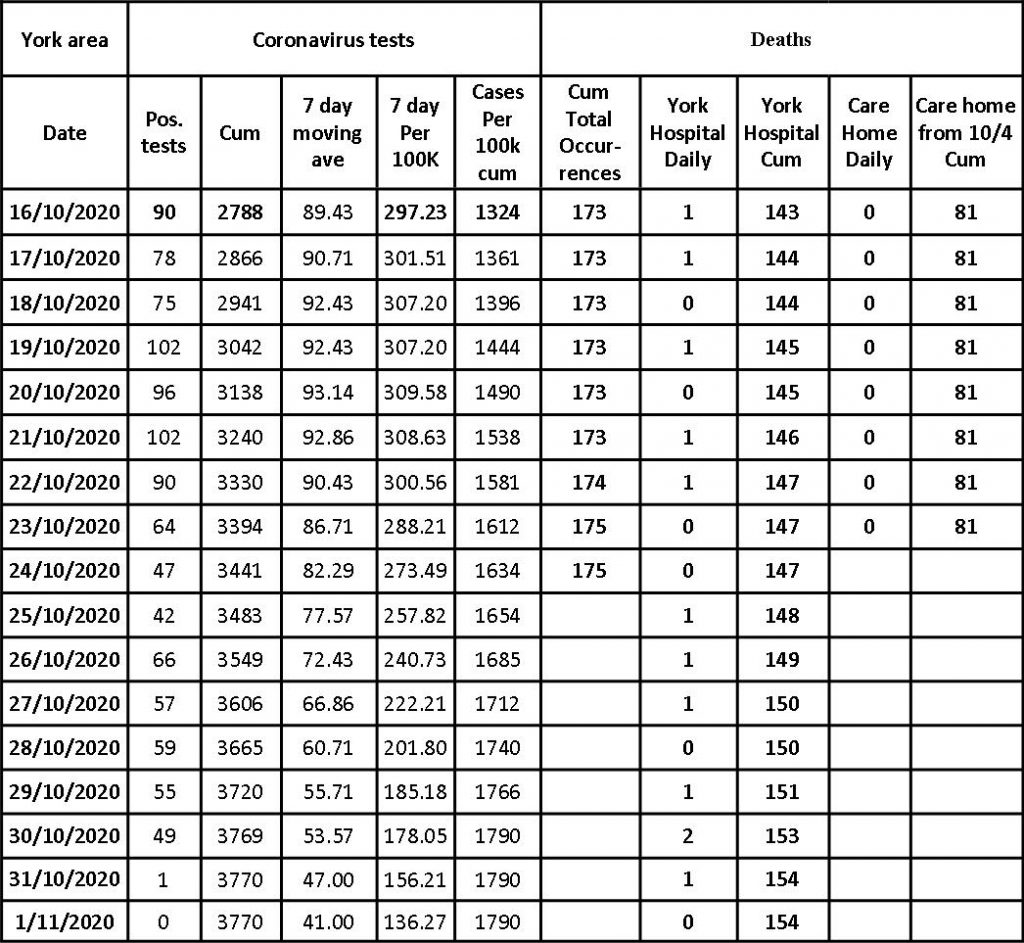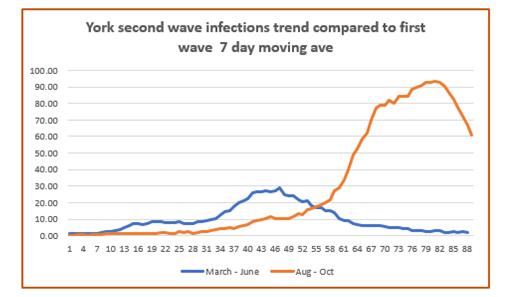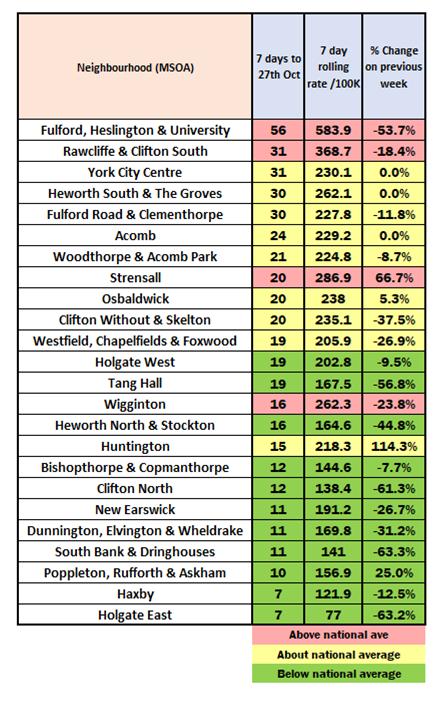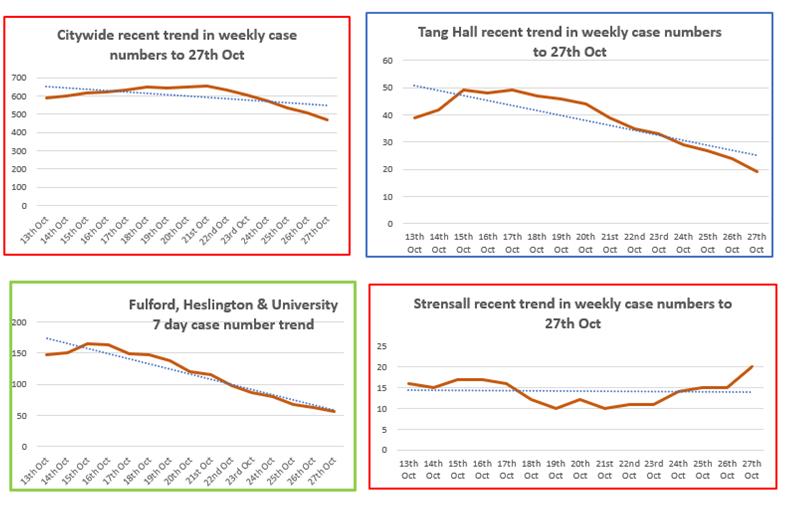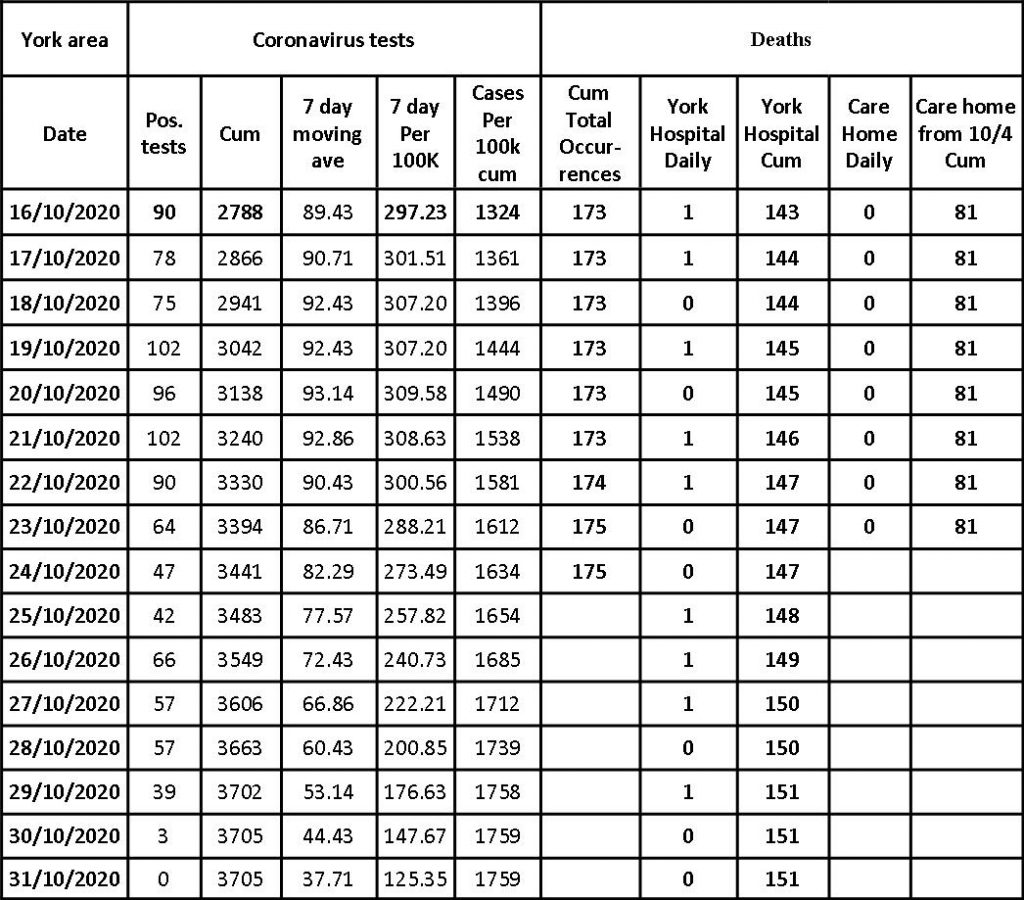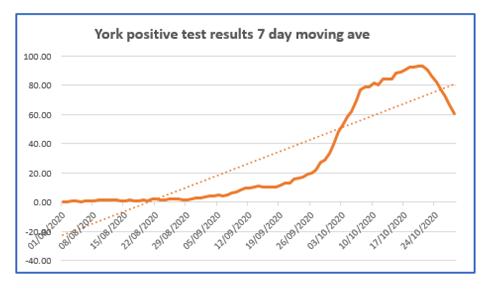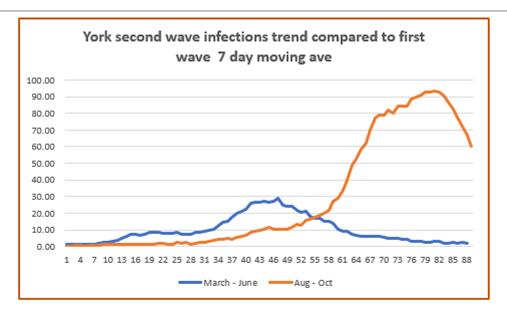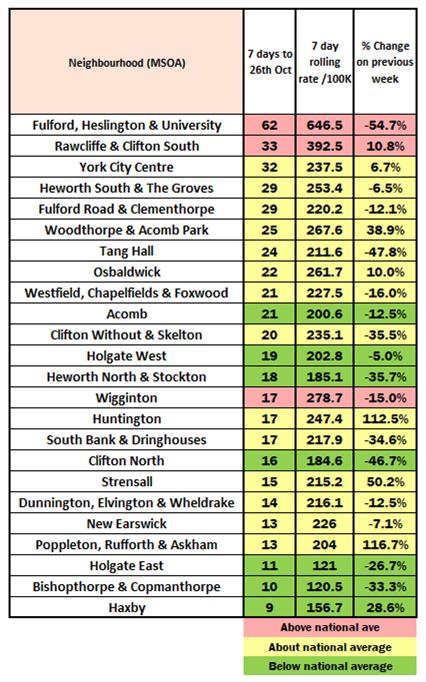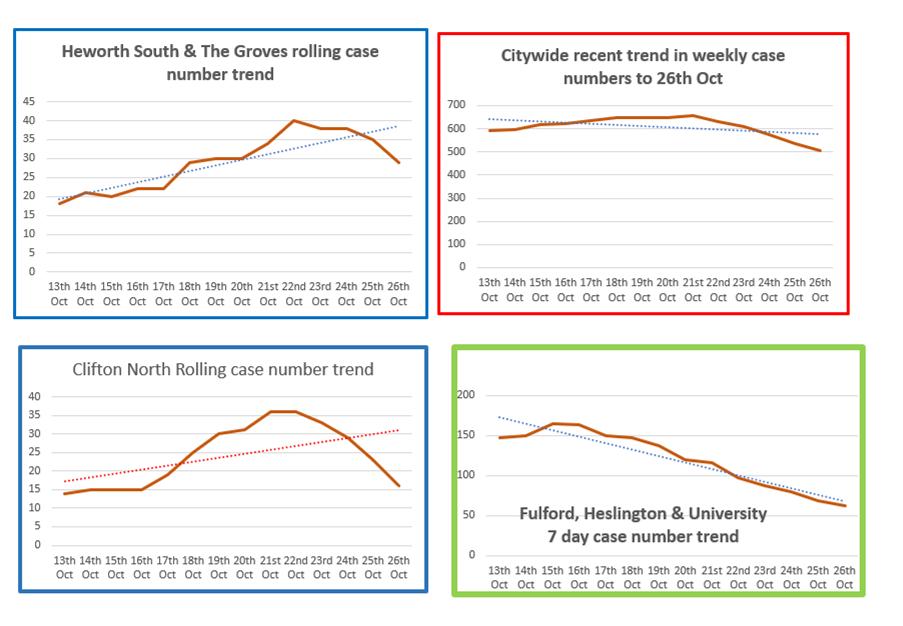Deaths and test results
Number of Coronavirus cases in City passes 4000
There have been no additional deaths at York Hospital Trust announced today.
56 (FIFTY SIX) additional positive test results announced today bringing the cumulative total to 4040. The 3000 case milestone was passed on 19th October.
The rate of infection has now stabilised at 56 new cases each day. To put this into figure context the highest new case rate number record during the first wave was 29.1 on 5th May. (There has been a higher testing rate recently).
The infection rate in the City is still below the county, regional and national rate.
Only two wards (Heslington and Strensall) are above the national average infection rate.
All the figures predate the lockdown period which started yesterday. It will be at least a week before the impact of the new restrictions on infection rates can be monitored.
Updated Council briefing
The data is accurate as at 8.00 a.m. on Friday 06.11.20. Some narrative for the data covering the latest period is provided here below:
People with Covid Symptoms
• NHS Pathways/111 triages – as at 2.11.20 there had been 199 total covid triages in the CYC area in the last 7 days. The peak number of triages was 653 in the 7 day period to 20.9.20.
• As at 5.11.20, the Covid Symptom App estimates 677.8 per 100,000 in York with symptomatic covid (responses from a sample of 5,058 people). The peak rate was 1,116.3 on 31.10.20.
Diagnosed cases (Pillar 1&2 combined)
• As at 5.11.20 York has had 3,984 cases since the start of the pandemic, a rate of 1,892 per 100,000 of population. The rate in York is above the national average (1,697.1) but below the regional average (2,666.9).
• The PHE ‘Exceedance’ rating compares the no. of new cases over a 14 day period with the previous 6 weeks and provides a RAG rating to indicate if the previously observed trend in the no. of new cases is worsening. The latest rating for York (2.11.20) is Green.
• The provisional rate of new Covid cases per 100,000 of population for the period 28.10.20 to 3.11.20 in York is 178.05 (using data published on Gov.uk on 5.11.20).
• The latest official “validated” rate of new Covid cases per 100,000 of population for the period 25.10.20 to 31.10.20 was 184.2. The national and regional averages at this date were 231.0 and 410.5 respectively (using data published on Gov.uk on 5.11.20).
• As at 2.11.20, the latest 7 day positivity rate in York (Pillar 2 only) was 11.8%. The national and regional averages are 11.3% and 17.3% respectively. The number of Pillar 2 tests being carried out in York has fallen by about a quarter in the last week.
• As at 5.11.20 York University reported 66 individuals within the University community who were currently self-isolating because they have had a positive COVID-19 test.
• As at 4.11.20 York St. John reported 22 individuals within the University community who were currently self-isolating because they have had a positive COVID-19 test.
Contact Tracing
• Since 28.5.20 a total of 3,418 laboratory confirmed CYC Covid cases have been uploaded into the NHS Test and Trace system and 2,943 of the cases have been engaged. 10,486 ‘contacts’ have been identified and 6,174 of these have been traced.
Deaths
The two sources about deaths from Covid-19 at LA level are ONS data and local registrar data. They are derived from the same source (civil registration data). ONS data is more comprehensive as it includes deaths of York residents which have occurred and been registered outside York. Local registrar data is useful as it provides a breakdown by age and gender. The most recently available data is summarised below:
• ONS weekly data: For deaths occurring up to 23rd October 2020 and registered up to 31st October 2020, 176 deaths were recorded as having occurred for CYC residents (84 in hospital, 78 in care homes, 10 at home and 4 in a hospice). The number of deaths per 100,000 of population in York is 83.56 which is lower than the national average of 93.06. The most recent death reported for a York resident occurred in week 43 (17 to 23 October).
• ‘Excess’ deaths (ONS). In week 43 (17 Oct to 23 Oct), 37 deaths occurred for York residents, which is 4 more than the average weekly number for 2014-18. Over the last 22 weeks the total number of deaths in York has been 36 fewer than the average for the equivalent weeks in 2014-18.
• Local Registrar data: In the weekly data received on 2.11.20 (for deaths occurring up to 28.10.20), a cumulative total of 168 deaths of CYC residents where COVID-19 was mentioned (confirmed or suspected) on the death certificate, have been registered. The average age of the people who died was 82.6, with an age range of 53-104. The age profile of those dying in York is slightly older than the national average. 88 of the 168 were male (52.4%), slightly less than the national average (55.2%). 72 people (42.9%) died in nursing /care homes (the national average is 28.6%). In addition 13 people (7.74%) who normally resided in nursing/care homes in the CYC area, died in hospital.
Data on deaths occurring in hospital are shown below. Deaths are initially reported for York NHS Foundation Trust which includes Scarborough Hospital and the further breakdown by site can be delayed. From local registrar data, 55.1% of COVID-19 deaths occurring at York Hospital have been CYC residents. (NB NHS Trusts record deaths following a positive covid-19 test (within 28 days) whereas ONS record deaths where covid-19 in mentioned on the death certificate so the totals are not the same).
• Deaths at York Hospital: As at 5.11.20, 149 deaths (awaiting confirmation of breakdown by hospital site for recent deaths) where the person had tested positive for COVID-19 and were being cared for at York Hospital have been reported. 237 deaths have been reported by the wider York NHS Trust.
Economic support
The Government has announced a series of economic support measures to coincide with the national measures:
• Business premises forced to close in England due to local or national restrictions are to receive grants worth up to £3,000 a month under the Local Restrictions Support Grant.
• For properties with a rateable value of £15k or under, grants to be £1,334 per month, or £667 per two weeks;
• For properties with a rateable value of between £15k-£51k grants to be £2,000 per month, or £1,000 per two weeks;
• For properties with a rateable value of £51k or over grants to be £3,000 per month, or £1,500 per two weeks.
• £1.1 billion is being given to local authorities, distributed on the basis of £20 per head, for one-off payments to enable us to support businesses more broadly.
The LGA and councils are engaging closely with central government officials on what these business support measures mean for councils, including new burdens payments and what happens with grants previously announced such as the discretionary support for ‘Tier 2’ areas. We will update you on this in future bulletins as we receive further information.
The Government has also announced –
•The Coronavirus Job Retention Scheme has been extended until December with employees receiving 80 per cent of their current salary for hours not worked, up to a maximum of £2,500. The LGA guidance on the scheme has been updated. The Government has confirmed that partially publicly funded bodies may be eligible to access the scheme where their private revenues have been disrupted.
•The Government announced today that support for self-employed people will rise to 80 per cent of trading profits during November.
•Mortgage holidays will also no longer end. The Financial Conduct Authority will announce further information today.
If the new government schemes have missed your business that needs help please email economicgrowth@york.gov.uk
For more information visit https://www.york.gov.uk/BusinessSupport?mc_cid=af5d308e56&mc_eid=b6a0c91609#grant
Extension to furlough
The national furlough scheme has today been extended by The Chancellor until March 2021. The scheme will continue to pay up to 80% of a person’s wage up to £2,500 a month. The scheme will be reviewed in January 2021.
As part of the revised scheme, anyone made redundant after 23 September can be rehired and put back on furlough.
The next self-employed income support grant will also increase from 55% to 80% of average profits – up to £7,500
For more information visit https://www.gov.uk/government/news/government-extends-furlough-to-march-and-increases-self-employed-support
